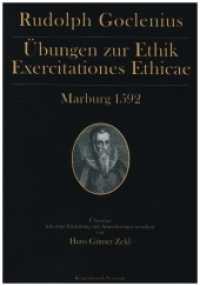- ホーム
- > 洋書
- > 英文書
- > Nature / Ecology
Full Description
Studies of the evolution of animal signals and sensory behaviour have more recently shifted from considering 'extrinsic' (environmental) determinants to 'intrinsic' (physiological) ones. The drive behind this change has been the increasing availability of neural network models. With contributions from experts in the field, this book provides a complete survey of artificial neural networks. The book opens with two broad, introductory level reviews on the themes of the book: neural networks as tools to explore the nature of perceptual mechanisms, and neural networks as models of perception in ecology and evolutionary biology. Later chapters expand on these themes and address important methodological issues when applying artificial neural networks to study perception. The final chapter provides perspective by introducing a neural processing system in a real animal. The book provides the foundations for implementing artificial neural networks, for those new to the field, along with identifying potential research areas for specialists.
Contents
Introduction. Modelling perception with artificial neural networks; Part I. General Themes: 1. Neural networks for perceptual processing: from simulation tools to theories K. Gurney; 2. Sensory ecology and perceptual allocation: new prospects for neural networks Steven M. Phelps; Part II. The Use of Artificial Neural Networks to Elucidate the Nature of Perceptual Processes in Animals: 3. Correlation versus gradient type motion detectors: the pros and cons A. Borst; 4. Spatial constancy and the brain: insights from neural networks R. L. White III and L. H. Snyder; 5. The interplay of Pavlovian and instrumental processes in devaluation experiments: a computational embodied neuroscience model tested with a simulated rat F. Mannella, M. Mirolli and G. Baldassarre; 6. Evolution, (sequential) learning and generalization in modular and nonmodular visual neural networks R. Calabretta; 7. Effects of network structure on associative memory H. Oshima and T. Odagaki; 8. Neural networks and neuro-oncology L. Douw, C. J. Stam, M. Klein, J. J. Heimans and J. C. Reijneveld; Part III. Artificial Neural Networks as Models of Perceptual Processing in Ecology and Evolutionary Biology: 9. Evolutionary diversification of mating behaviour: using artificial neural networks to study reproductive character displacement and speciation K. S. Pfennig and M. J. Ryan; 10. Applying artificial neural networks to the study of prey coloration S. Merilaita; 11. Artificial neural networks in models of specialization, guild evolution and sympatric speciation N. M. A. Holmgren, N. Norrstrom and W. M. Getz; 12. Probabilistic design principles for robust multimodal communication networks D. C. Krakauer, J. Flack and N. Ay; 13. Movement-based signalling and the physical world: modelling the changing perceptual task for receivers R. A. Peters; Part IV. Methodological Issues in the Use of Simple Feedforward Networks: 14. How training and testing histories affect generalization: a test of simple neural networks S. Ghirlanda and M. Enquist; 15. The need for stochastic replication of ecological neural networks C. R. Tosh and G. D. Ruxton; 16. Methodological issues in modelling ecological learning with neural networks D. W. Franks and G. D. Ruxton; 17. Neural network evolution and artificial life research D. Curran and C. O'Riordan; 18. Current velocity shapes the functional connectivity of benthiscapes to stream insect movement J. D. Olden; 19. A model biological neural network: the cephalopod vestibular system R. Williamson and A. Chrachri.








